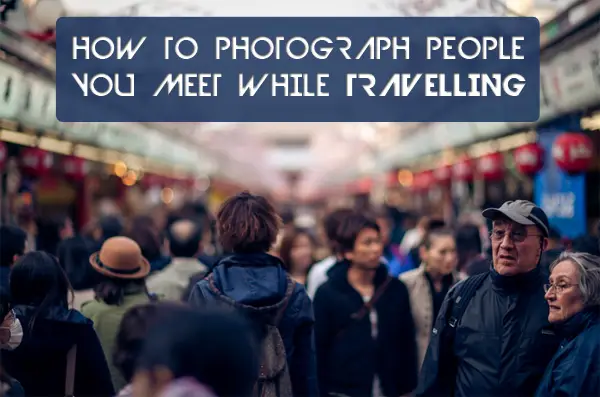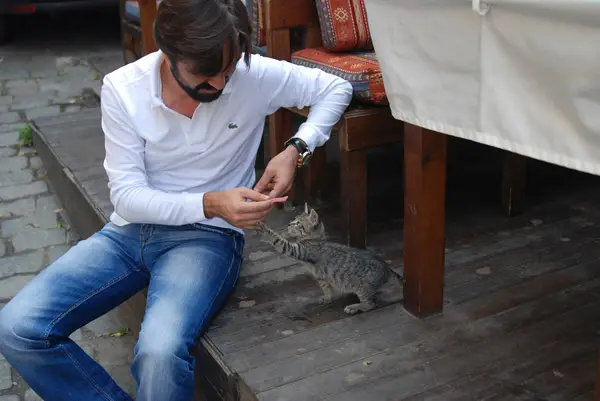Imagine this scenario: You’re walking down a side street in Bangkok in the late afternoon, and you pass by an old man sitting on his patio. He’s drinking a cup of tea and staring off into the distance, and he just exudes an aura of contentment. The light is perfect, and the viewfinder in your mind’s eye composes the perfect shot, but you hesitate.

You don’t want to disturb him, but you also don’t want to just start clicking away without his permission. Also, your Thai is mostly non-existent, and you probably couldn’t ask him for his picture even if you wanted to. So what do you do?

Here are 10 actions you can do to help you capture pictures of people you meet while traveling. There are 6 things you should do before you leave home, as well as 4 tips to help you when you’re on the scene. These techniques will help you come out from hiding behind your camera, get the shot you want, and possibly even start new friendships. These tips are geared more towards international travel, when you won’t necessarily be able to speak the local language, but you can also use them the next time you take a walk around your own neighborhood.
BEFORE YOU GO: BE PREPARED BUT FLEXIBLE
This is the most important rule to follow when taking pictures and traveling – and it’s not a bad rule of thumb for life, either! Prepared and flexible can seem like opposite ideas, but you want to strike a balance between the two. Here are six concrete actions you can do before you even leave home:
1. Do some research and preparation
Think about where great photos might be waiting to be “discovered.” Locate places like markets, religious sites, or public parks, but also be aware of potential tourist traps. Also consider using apps like Stuck on Earth for guidance and inspiration. Unless you specifically want posed portraits, find places where local people will act naturally. For each day on your trip, identify two or three new locations which sound promising, but don’t let your plans be so rigid that they prevent you from finding opportunities while on the move. Be prepared to explore.

2. Find a “local” or a “native”
To learn more about special customs or good locations to shoot, talk to people from the area you’re going to visit. A native’s insight can be very important and help more than any internet search. He or she can help you with things like gestures and body language, and can also indicate if there are places, people, or circumstances that are inappropriate for photography.
3. Learn – and write down!
Sentences like “May I take your picture?” are important, but a simple phrase to introduce yourself can be just as useful in some situations. Fill a note card with phrases and use it as a “cheat sheet.” No one expects you to speak the language perfectly, but a little effort can go a very long way in building up good will between strangers. Your local contact from item number 2 can also be especially helpful here. Before you go, double-check to be sure your phrases make sense and that you know how to say them correctly. When asking someone for their photo, the last thing you want is to make a vocabulary mistake that results in you proposing marriage to their cat.

4. Bring some business cards
Even amateur photographers can prepare contact cards or slips of paper with an email address and links to online photo accounts on sites like Flickr or Picasa. You can also use those cards to note the date you took the photo (so your subject can find it later) or to have your subject write his or her contact info (so you can add it to your photo log, and possibly send them a copy of their picture).
5. (Almost) everyone likes candy, so bring some
Especially if you might be photographing children, put some little sweets or gum in your gear bag. Kids normally aren’t impressed by business cards, but a piece of new “foreign” candy can make their day. Be sure to ask their parents first, though! “Don’t take candy from strangers” is like the Esperanto of parental advice.

6. Always carry an extra battery and memory card
You probably do this already, but just double-check before you leave for the day. If you take someone’s picture, there’s a natural tendency for them – especially kids – to be curious about how the pictures are turning out. The business cards and candy can help build up good will, but for instant gratification there’s nothing like simply showing the subject your camera’s display. That can also drain your battery, so be prepared.
WHEN YOU SEE A PHOTO OPPORTUNITY: BE DIRECT BUT POLITE
So, you’ve done your homework and you’re prepared. Now you’re in-country and you see someone you want to photograph. What exactly should you do?

Like being prepared but flexible, you need to find a balance between being direct but polite. This is particularly true if you don’t speak the local language well. Taking pictures of people in their everyday routine may be interesting for you, but for them, it’s routine. It’s not special for them, so the idea that an outsider wants to take their picture can make them suspicious of you or your intentions.
Here are four more tips to help put your subject at ease and ensure that your photo session goes well:
7. Use gestures
Use gestures, but make sure they’re appropriate gestures. Communication breaks down even in the best of situations. You might find yourself shyly whispering near-gibberish like, “You foto?” or, “I may can, yes?” while gesturing your camera towards your subject like you’re trying to sell them a box of wet matches. Don’t worry; simply pointing at your camera and hopefully raising your eyebrows will probably get your point across. Then, once you start taking pictures and showing them to the subject, those pictures will truly be worth a thousand words.
8. Be friendly
Be friendly but not insistent. Remember, you’re on their turf so they’re the ones who will call the shots. If you can, introduce yourself and explain that you’d like to take their picture, with their permission. If they say no, thank them anyway and move on.

A side note: when people are drinking enormous beers and watching sports, they’re often VERY happy and open to having their picture taken (when their team is winning). However, it’s just as likely that they’re very angry because their team is losing, and taking their picture can lead to situations much more uncomfortable than asking permission to take pictures. Shoot with caution.
9. Give something back
Sure, your contact cards are lovely, but if a woman selling fruit lets you take pictures of her for a half hour, you should strongly consider buying a nice, refreshing orange – or a whole bag of them! They’re helping you out, so do what you can to help them.

10. Permission
If you’re in a large open area or a place with a lot of people, you may not need anyone’s permission to take photos, but still be respectful. Such areas lead to great pictures if you can capture people doing things naturally, without preparation or pretense. However, just because people are in a public park, doesn’t mean they want their picture taken. You’re not a spy, so it’s OK if it’s obvious that you’re taking pictures (but not so obvious as to get your camera stolen). If anyone looks uncomfortable or seems to object to what you’re doing, stop right away. And if anyone asks to see your pictures, show them: it could even lead to your next photo opportunity!

If you follow these tips while traveling, you’ll find that taking pictures of people can go from an intimidating task to a genuinely enjoyable experience. You’ll be able to take home more great shots, and possibly even some new friendships.
These are my “secrets” – what are yours? Have you tried any of these techniques, or do you have any of your own that you’d like to share?
About the author: Ryan Sitzman is an English and German teacher, an amateur photographer and writer, and an avid traveler. He also knows how to drive a bus and can give medicine to cows. He lives in Costa Rica. You can find out more at his personal website.









Lovely article. As an Argentinian I love the two example you mentioned from this coutry. Great info about this simple but not so considered topic.
Hey Fabricio,
Thanks for reading and for your comment! I really enjoyed the two trips I’ve taken to your country–it’s one of my favorite places, and I hope I’ll be able to go there again some day.
Have a good one!
Ryan
Great tips! Often, having a camera can help break down certain barriers, but if someone is unprepared (which everyone likes to say that they’re not photogenic) then those barriers can quickly go back up. Like you said, it’s often as simple as pointing to your camera and asking with your eyes or gestures. Then at least they know that you’re friendly enough to engage with them and not a spy, trying to steal the recipe for their rice krispie treats. Looking forward to your next article!
Hi Paul,
Thanks for taking the time to read and reply to the article–I’m glad you liked it!
It’s definitely true what you say about people believing they’re not photogenic, not interesting, not made-up or “ready,” etc. A lot of people maybe just don’t want to seem self-absorbed or…well, who knows?
Actually, a few hours after I took the picture of the kid in Nicaragua, I asked to take a picture of my friend’s friends in their house. The mother refused at first because she wasn’t made up, but then she asked me to wait while she “got ready.” So about 15 minutes later she came out with different clothes and makeup and I got a nice shot of her and her daughter.
I guess the point is that even events that initially seem like setbacks can sometimes work out well.
That kid looked super happy you brought him a piece of candy. Clever. And slightly disconcerting. Overall, great tips. I especially like the cat in Istanbul pic.
infact i used to photograph people according to their interest
A very important topic so well done for raising awareness and offering good advice. I think your last point summarises the issue best – it’s about respect